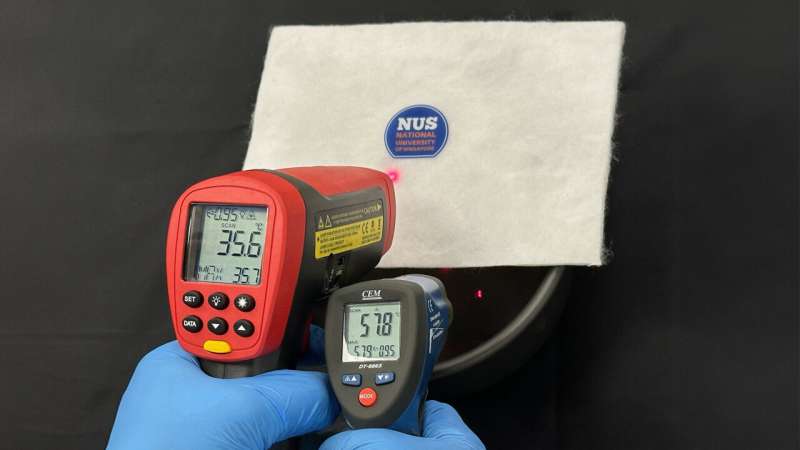This article has been reviewed according to Science X's editorial process and policies. Editors have highlighted the following attributes while ensuring the content's credibility:
fact-checked
peer-reviewed publication
trusted source
proofread
Researchers develop new aerogels for radiative cooling and the absorption of electromagnetic waves

Aerogels, known for their porosity and low density, are solid materials that offer versatile functionality—from gobbling up fat globules in weight-management supplements to facilitating more sustainable metal-recycling processes.
Traditionally used to provide thermal insulation in the aerospace industry, scientists from the National University of Singapore (NUS) have taken the material to the next level—harnessing its unique properties to provide value to numerous applications in building and construction, environmental remediation, drug delivery, and even clothing and textiles.
In a pioneering effort, a research team led by Associate Professor Duong Hai-Minh from the Department of Mechanical Engineering under the NUS College of Design and Engineering, has developed aerogels for two new applications: radiative cooling and electromagnetic wave (EMW) absorption.
Using plastic waste, the team engineered thin-film aerogels that function as thermal insulators and radiative coolers. These aerogels can be applied to any surface, such as building roofs, to reduce internal temperatures, offering a scalable and sustainable solution for energy-free thermal management. The team's findings were published in the journal Solar Energy on 15 May 2024.
In another study, published in the journal Carbon on 10 February 2024, the NUS researchers devised a simple, scalable method to produce aerogels that absorb EMWs in the X-band, characteristic of those used in weather monitoring and air traffic control. These lightweight, durable aerogels protect against electromagnetic pollution, shielding both humans and sensitive equipment in our increasingly digital world.
The researchers' work builds on their prior successes in developing aerogels from a variety of waste materials, from plastics and paper to agricultural by-products such as pineapple leaves.
Aerogels for radiative cooling
Traditional cooling systems, such as air conditioners, have a ravenous appetite for energy, accounting for approximately 20% of electricity used in buildings worldwide. The new aerogels developed by the NUS team present a passive cooling alternative, leveraging the natural process of radiative cooling to dissipate heat into space without consuming energy.
"This process involves using specially engineered aerogels to emit infrared radiation through the atmospheric 'sky window,' effectively cooling surface temperatures below ambient levels," said Assoc. Prof. Duong. "We are excited to be able to upcycle fibers from disposable polyethylene terephthalate (PET) bottles for the new aerogels designed for this purpose, to help address the global plastic waste crisis."
Previously the team had worked with PET fibers to produce aerogels, but this latest method is significantly more energy-efficient, consuming about 97% less energy and reducing production time by 96%.
When tested in Singapore's warm climate, conducted in collaboration with Dr. Jaesuk Hwang from the Center for Quantum Technologies at NUS, 0.5 centimeters of the material produced a cooling effect of 2°, achieved by emitting infrared heat into the surroundings while exhibiting good heat insulation, preventing heat absorption from the surrounding environment.
"These aerogels could reduce energy consumption in both residential and commercial buildings, especially in tropical climates where cooling is now a necessity," added Assoc. Prof. Duong.
Future research will focus on adapting these aerogels for diverse climatic conditions and expanding their applications beyond building insulation, such as in industrial processes where the efficient thermal management of liquid circulation pipes is crucial.
Aerogels for electromagnetic wave absorption
Modern electronic devices emit EMWs that can disrupt nearby equipment and pose health risks, including DNA damage and cancer. It is critical, therefore, to develop materials that can effectively absorb EMWs to shield both humans and infrastructure from these adverse effects. Applications include enhancing the privacy and security of buildings as well as protecting sensitive medical equipment.
To address this need, Assoc. Prof. Duong's team has developed a scalable and eco-friendly procedure to produce novel aerogels that are effective at EMW absorption. The process involves blending three main components—carbon nanotubes, polyvinyl alcohol and carboxymethyl cellulose—followed by freeze-drying.
The aerogel, with a thickness of about 3 millimeters—roughly the width of 40 strands of human hair—demonstrated an impressive performance of absorbing 99.99% of EMW energy. Across the entire X-band (8.2–12.4 GHz) of the electromagnetic spectrum, used primarily for radar systems, weather monitoring and air traffic control, the aerogel consistently showed its ability to absorb 90% of EMW energy.
"In addition to offering a wide absorption bandwidth of 1.2–2.2 GHz in the X-band, our aerogel is also about 10 times lighter than existing composites used for EMW absorption," added Assoc. Prof. Duong. "Unlike other composites, our aerogel requires no mixing with heavy polymer fillers before use."
The researchers have estimated that producing 1 square-meter of the aerogel, with a thickness of 1 centimeter, costs less than S$100. This cost is substantially lower than the price of other similar commercial materials, which could range from S$180 to above S$1,000.
Looking ahead, the team plans to refine the aerogel's mechanical properties, such as flexibility, to broaden their applicability across various building and infrastructure projects. The researchers also aim to conduct real-world tests to fully assess the EMW absorption capabilities of the aerogels in practical scenarios.
More information: Xue Yang Goh et al, Sub-ambient radiative cooling with thermally insulating polyethylene terephthalate aerogels recycled from plastic waste, Solar Energy (2024). DOI: 10.1016/j.solener.2024.112544
Luon Tan Nguyen et al, Scalable fabrication of lightweight carbon nanotube aerogel composites for full X-band electromagnetic wave absorption, Carbon (2024). DOI: 10.1016/j.carbon.2024.118811

















